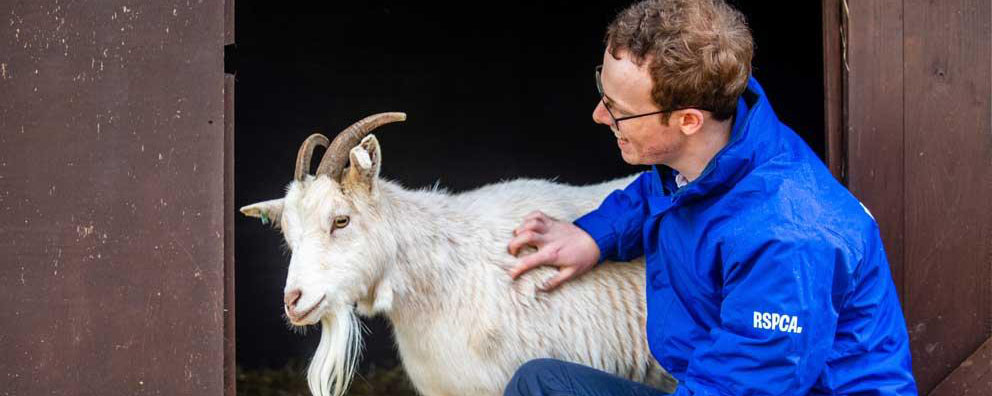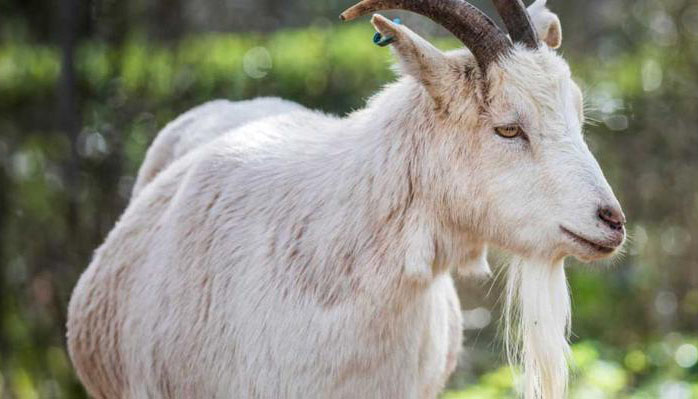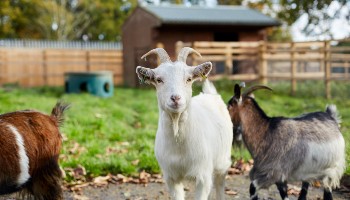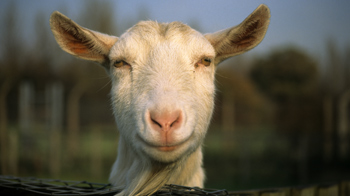Health and welfare
In general, healthy goats have:
- a strong, alert posture
- a good appetite and no signs of diarrhoea
- a strong, glossy coat, free from parasites
- clear, bright eyes
- no discharge from the nose.
They should:
- move freely and easily, on neat, healthy feet
- be engaged, alert and playful.
Every day, keep a lookout for signs of health problems, such as lameness, diarrhoea and parasites. Check for unusual bumps, lumps and changes in coat texture or udder appearance.
You should have them health-checked regularly by a vet, as well as keeping up to date with vaccinations, worming and foot care.
Always contact your vet if you're concerned about the health and welfare of your goats.
Good hygeine
Take care to always wash your hands after contact with your goats and use protective clothing when necessary. If a goat is ill, be extra careful as they can carry ‘zoonotic’ diseases that can be passed on to humans.
Pregnant women should avoid contact with goats.
Vaccinations
Talk to your vet about which vaccinations your goat will need (e.g. against clostridial diseases) and how often they’ll need a booster.
Possible health issues
Here are the main conditions that could affect your pet goats.
Scouring (diarrhoea)
Diarrhoea is common in goats. It can be caused by sudden changes in diet, internal parasites, eating poisonous plants or substances, and microbial infections. Contact your vet if the diarrhoea lasts for more than 24 hours, if there’s blood in their faeces, or if the goat deteriorates quickly.
Young goats (kids) can become rapidly dehydrated if they have diarrhoea, so talk to your vet immediately.
Lameness
Watch out for signs of lameness. If a goat starts to limp, favour a leg, become reluctant to stand up and move to lean when grazing, you need to act swiftly. Put them in a pen on dry straw, away from the other healthy animals. Ask a vet to inspect their feet and legs. Infectious diseases need to be treated as soon as possible or they could spread to other goats. Severely affected animals may need to be humanely euthanased.
Causes of lameness include:
- pain from items such as stones or thorns stuck in their feet, which may also get infected
- compacted mud or debris under or between the toes
- physical injury to legs or feed, such as bruises, cuts, sprains, dislocations and breakages
- ‘scald’ – an infectious bacterial disease of the skin between their toes that looks sore and swollen, sometimes with a greyish scum
- footrot – an infectious bacterial disease where the tissue on the soles of their feet begins to ‘rot’ and smell.
Mastitis
Signs of mastitis are:
- heat in the udder
- a change in udder size, texture or colour
- Pain in the udder
- blood or sediment in their milk
- a change in the quantity or consistency of their milk.
Mastitis can spread to other goats in the herd. You’ll need to regularly check the other animals – remember that both male and female goats have udders. If your goats need milking, ensure you use good hygiene in the milking parlour, wash your hands, and use an antiseptic spray on the teat after milking. Ask your vet for more advice.
Internal parasites
Take care to ask your vet about a worming routine to protect your goats. They can get a number of different internal parasites, such as lungworm, liver flukes and coccidia. These can cause the goat to quickly lose weight via chronic diarrhoea and even die.
In addition to medication, you can think about a rotational grazing system, which stops parasite eggs from building up in the pasture.
External parasites and other skin conditions
Lice and mite (mange) infestations are a common problem in goats. You should be able to spot lice in your goat’s coat, though mites may burrow into the skin. In general, if goats have started scratching or nibbling more at any area of their body – including their feet – talk to your vet.
Flystrike is when flies lay their eggs on goats and the eggs then hatch into maggots. This is more common in the warmer months. To help prevent this, clean your goat carefully if they have diarrhoea and even clip their coat around their bottom. Talk to your vet about treating any wounds with an antibiotic spray containing fly deterrent.
Ringworm is a fungal disease that causes round, bald patches and can be passed on to humans.
Caprine arthritis encephalitis virus (CAEV)
CAEV is an incurable viral disease of goats. In its later stages, it can cause severe problems such as loss of body condition, arthritis and mastitis. Vets can test for this disease, and it’s particularly worth having any new goats tested for it.
Watch your goat's behaviour
A goat’s behaviour can tell you a great deal about whether they’re healthy and their needs are being met. Spend time watching and interacting with your goats to get to know them and their regular behaviour and characteristics. If they change, you’ll notice.
Vocalisation – goats are generally quiet animals when they’re content. But they’ll vocalise loudly in certain situations, such as when they’re hungry or thirsty, injured or unwell. Females in season can also be noisy, as can uncastrated males when they can’t get access to the females.
Aggression/butting – in the wild, goats will gain social status by butting or rearing and clashing heads. This is fairly normal behaviour and is usually only from time to time and short-lived. Keep an eye out though in case some goats are getting an excessive amount of aggression from others. New goats, especially unfamiliar males, can receive a lot of aggression.




